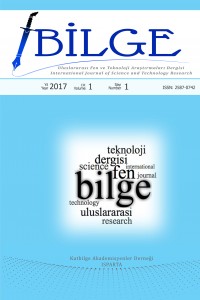Öz
Kaynakça
- [1] Karaboyacı, M., Modifiye Edilmiş Lignoselülozikler ile Ağır Metal Adsorpsiyonu, Süleyman Demirel Üniversitesi Fen Bilimleri Enstitüsü, Doktora Tezi, Isparta 2010.
- [2] Bandosz, T.J., Effect of Pore Structure and Surface Chemistry of Virgin Activated Carbons on Removal of Hydrogen Sulfid, Carbon,. 1999, 37: 483–491 doi:10.1016/S0008-6223(98)00217-6
- [3] Gergova, K., Eser, S., Effects of Activation Method the Pore Structure of Activated Carbons from Apricot Stone, Carbon, 1996, 34: 879–888 doi:10.1016/0008-6223(96)00028-0
- [4] Giraldo, L., Moreno-Piraján, J. C. Pb2+ adsorption from aqueous solutions on activated carbons obtained from lignocellulosic residues. Brazilian Journal of Chemical Engineering, 2008, 25(1), 143-151. Doi10.1590/S0104-66322008000100015
- [5] Tosun, İ., Gönüllü, M. T., Günay, A., Gül posasının kompostlaştırılmasına gözenek malzemesi ve aşının etkisi” Yıldız Teknik Üniversitesi Dergisi. 2003, 2003/2 pp 93-102
- [6] David. N. S. Hon (Ed.). Chemical modification of lignocellulosic materials. CRC Press, New York 1995.
- [7] Khambhaty, Y., Mody, K., Basha, S., Jha, B., Kinetics, equilibrium and thermodynamic studies on biosorption of hexavalent chromium by dead fungal biomass of marine Aspergillus niger. Chemical Engineering Journal, 2009, 145, 489-49 doi:10.1016/j.cej.2008.05.002
- [8] Fiol, N., Villaescusa, I., Martínez, M., Miralles, N., Poch, J., & Serarols, J. Sorption of Pb (II), Ni (II), Cu (II) and Cd (II) from aqueous solution by olive stone waste. Separation and purification technology, 2006, 50(1), 132-140. doi:10.1016/j.seppur.2005.11.016
- [9] Seydioğlu, G., Bitkisel Atıkların Granül Aktif Karbon Üretiminde Değerlendirilmesi. Anadolu Üniversitesi Fen Bilimleri Enstitüsü Çevre Müh. ABD Yüksek Lisans Tezi, Eskişehir 2009.
Öz
Nowadays environmental damage of heavy metals is increasing and that becomes a big problem for
human and human health. Especially after the industrial revolution, increasing of production and consumption
materials, adversely affect the environment. Among all the pollutions, heavy metal is an important part. Because
they are toxic or poisonous even at low concentration. The most widely used process is activated carbon
adsorption for heavy metal adsorption from wastewater. Activated carbon can produce from carbon containing
substances. Turkey is an important rose oil producer of the world and every year over 12 000 tons of rose
processing wastes produced. In this study, activated carbon was obtained from rose crops of rose oil factories.
There are some activation methods for increasing surface area of the carbon. In this study, potassium chlorate
(KClO3) was used for increasing carbons surface area. KClO3 never used before for activation. The thermal
decomposition of KClO3 (potassium chlorate) generates KCl and O2 gas. Effects of O2 gas outlet on the pore size
of activated carbon were studied. The surface characterization was examined with Brunauer-Emmett-Teller
(BET) analysis and Pb+2 adsorption capacity of obtaining activated carbon was determined by inductively
coupled plasma optical emission spectrometry (ICP OES) analysis.
Anahtar Kelimeler
rose waste KClO3 activation waste utilization Pb+2 adsorption
Kaynakça
- [1] Karaboyacı, M., Modifiye Edilmiş Lignoselülozikler ile Ağır Metal Adsorpsiyonu, Süleyman Demirel Üniversitesi Fen Bilimleri Enstitüsü, Doktora Tezi, Isparta 2010.
- [2] Bandosz, T.J., Effect of Pore Structure and Surface Chemistry of Virgin Activated Carbons on Removal of Hydrogen Sulfid, Carbon,. 1999, 37: 483–491 doi:10.1016/S0008-6223(98)00217-6
- [3] Gergova, K., Eser, S., Effects of Activation Method the Pore Structure of Activated Carbons from Apricot Stone, Carbon, 1996, 34: 879–888 doi:10.1016/0008-6223(96)00028-0
- [4] Giraldo, L., Moreno-Piraján, J. C. Pb2+ adsorption from aqueous solutions on activated carbons obtained from lignocellulosic residues. Brazilian Journal of Chemical Engineering, 2008, 25(1), 143-151. Doi10.1590/S0104-66322008000100015
- [5] Tosun, İ., Gönüllü, M. T., Günay, A., Gül posasının kompostlaştırılmasına gözenek malzemesi ve aşının etkisi” Yıldız Teknik Üniversitesi Dergisi. 2003, 2003/2 pp 93-102
- [6] David. N. S. Hon (Ed.). Chemical modification of lignocellulosic materials. CRC Press, New York 1995.
- [7] Khambhaty, Y., Mody, K., Basha, S., Jha, B., Kinetics, equilibrium and thermodynamic studies on biosorption of hexavalent chromium by dead fungal biomass of marine Aspergillus niger. Chemical Engineering Journal, 2009, 145, 489-49 doi:10.1016/j.cej.2008.05.002
- [8] Fiol, N., Villaescusa, I., Martínez, M., Miralles, N., Poch, J., & Serarols, J. Sorption of Pb (II), Ni (II), Cu (II) and Cd (II) from aqueous solution by olive stone waste. Separation and purification technology, 2006, 50(1), 132-140. doi:10.1016/j.seppur.2005.11.016
- [9] Seydioğlu, G., Bitkisel Atıkların Granül Aktif Karbon Üretiminde Değerlendirilmesi. Anadolu Üniversitesi Fen Bilimleri Enstitüsü Çevre Müh. ABD Yüksek Lisans Tezi, Eskişehir 2009.
Ayrıntılar
| Konular | Çevre Mühendisliği |
|---|---|
| Bölüm | Araştırma Makaleleri |
| Yazarlar | |
| Yayımlanma Tarihi | 10 Temmuz 2017 |
| Yayımlandığı Sayı | Yıl 2017 Cilt: 1 Sayı: 1 |

